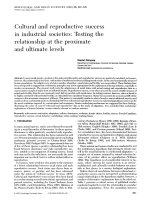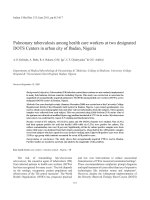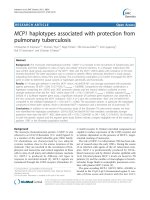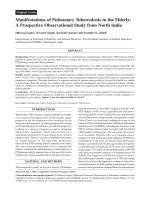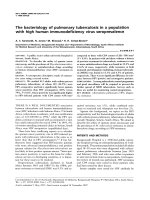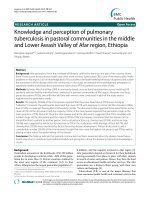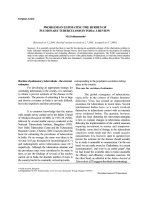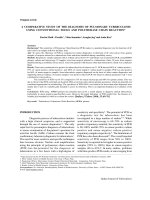MYCOBACTERIAL SPECIES CAUSING PULMONARY TUBERCULOSIS AT THE KORLE BU TEACHING HOSPITAL, ACCRA, GHANA pptx
Bạn đang xem bản rút gọn của tài liệu. Xem và tải ngay bản đầy đủ của tài liệu tại đây (150.22 KB, 6 trang )
June 2007 Volume 41, Number 2 GHANA MEDICAL JOURNAL
52
MYCOBACTERIAL SPECIES CAUSING PULMONARY TUBER-
CULOSIS AT THE KORLE BU TEACHING HOSPITAL, ACCRA,
GHANA
*
K.K. ADDO, K. OWUSU-DARKO, D. YEBOAH-MANU, P. CAULLEY
1
, M. MINAMI-
KAWA, F. BONSU
2
, C. LEINHARDT
3
, P. AKPEDONU and D. OFORI-ADJEI
Bacteriology Department, Noguchi Memorial Institute for Medical Research, P.O. Box LG 581, Le-
gon, Ghana,
1
National Public Health Reference Laboratory, Korle-Bu, Ghana,
2
National Tuberculosis Control Programme, Korle-Bu, Ghana and
3
West African TB Research Initiative, Dakar, Senegal
*
Author for correspondence
SUMMARY
Objective: Characterize mycobacterial species
causing pulmonary tuberculosis (PTB) at the
Korle-Bu Teaching Hospital in Ghana.
Design: Sputum smear positive samples, two (2)
from 70 patients diagnosed as having tuberculosis,
after they had consented, were collected from the
Korle-Bu Teaching Hospital Chest Clinic between
January and July 2003.
Setting: Korle-Bu Teaching Hospital Chest Clinic,
Accra.
Results: Sixty-four mycobacterial isolates were
obtained and confirmed as members of Mycobac-
terium tuberculosis complex by colonial morphol-
ogy and conventional biochemical assays. Forty-
seven (73%) were M. tuberculosis, the human
strain, 2 (3%) M. bovis, the bovine strain, 13
(20%) M. africanum I (West Africa type), and 2
(3%) M. africanum II (East Africa type).
Conclusion: The results indicate that, there are
various strains causing PTB at the Korle-Bu
Teaching Hospital and of great concern is M. bo-
vis, which mostly causes extra-PTB in humans but
found to cause PTB in this study. This calls for the
need to conduct a nationwide survey using both
conventional and molecular techniques to charac-
terize various mycobacterial species causing TB in
Ghana. This will result in better understanding of
the various strains circulating in the country and
inform individual TB treatment regimen especially
the inclusion or exclusion of pyrazinamide.
Keywords: M. tuberculosis, M. africanum, M.
bovis, Pulmonary Tuberculosis, Bovine Tubercu-
losis
INTRODUCTION
Tuberculosis (TB), a disease of great antiquity
continues to be a major public health problem
worldwide. One-third of the world’s over six bil-
lion population is infected with the tubercle bacilli
with over two million deaths annually
1
.
The available data on TB in Ghana indicate that
the disease burden is high and TB remains an im-
portant cause of major disability and death in the
country
2
. With Ghana’s population of over 20 mil-
lion, The World Health Organization (WHO) es-
timates 44,041 new cases of all forms of TB in
Ghana corresponding to a TB incidence rate of 211
per 100,000 inhabitants of whom 19,285 are smear
positive cases
3
.
This upsurge of TB is attributed to factors such as
HIV/AIDS, poverty, population growth, over-
crowding, malnutrition, stress, drugs and alcohol
abuse, consumption of contaminated meat and
milk and multi-drug resistant (MDR) TB.
TB is known to be caused mainly by the mamma-
lian tubercle bacilli, Mycobacterium tuberculosis
complex, which consists of closely related species.
The species are M. tuberculosis, M. bovis, M.bovis
Bacillus Calmette-Guérin (BCG), M. africanum,
M. microti, M. canetti and M. pinnipedii
4,5,6
. M.
tuberculosis principally causes TB in humans but
can affect animals that have contact with infected
humans. It causes mainly pulmonary type of TB
but extra-pulmonary type has also been reported.
M. bovis which causes bovine TB affects cattle,
humans, sheep, goats, pigs and several other do-
mestic and wild animals. M. bovis BCG on the
other hand is termed the vaccine strain and can
cause disseminated BCG infection in vaccinated
children
7
. M. africanum is considered to be an in-
June 2007 K.K. Addo et al Causative agents of pulmonary TB
53
termediate species between M. tuberculosis and M.
bovis, being closer to the latter
8
. The organism
causes TB in humans and occasionally animals
such as apes
9
. M. microti which is attenuated in
humans is a member of the complex and termed
the vole bacillus as it causes TB in voles (Microtus
agrestis) and other small rodents such as hamsters,
shrews, rats, mice, rabbits and guinea-pigs
10
. M.
canetti is rarely seen but can cause TB in humans
5
whereas M. pinnipedii is described as the seal ba-
cillus for causing TB in fish-eating sea animals
6
.
Differentiation within the complex is necessary for
epidemiological purposes and some individual
patient treatment
11
. However, in Ghana as in most
developing countries, TB is mostly diagnosed by
sputum smear microscopy (SSM) which cannot
differentiate members of the complex. Routine
acid-fast bacilli (AFB) culture and identification of
isolates are not performed due to lack of well
equipped laboratory facilities. With the establish-
ment of biosafety level 3 (P3) mycobacterial la-
boratory at Noguchi Memorial Institute for Medi-
cal Research (NMIMR), a study was initiated in
2003 with the main objective of characterizing
mycobacterial species causing pulmonary tubercu-
losis in patients attending the Korle-Bu Teaching
Hospital Chest Clinic in Accra, Ghana. This was
after ethical clearance was granted by the Insti-
tutes’ ethical review board on research.
MATERIALS AND METHODS
Sample Collection
Sputum smear positive samples, two (2) from each
patient diagnosed as having tuberculosis, after they
had consented were collected from the Chest Clin-
ic of the Korle-Bu Teaching Hospital (KBTH)
which acts as national referral clinic, between Jan-
uary and July 2003. Samples were taken from se-
venty patients into sterile plastic containers and
transported immediately to the Bio-safety Level 3
(P3) TB Laboratory at NMIMR for processing:
microscopy, culture and identification.
Sputum Smear Microscopy
To be certain that the samples were positive; spu-
tum smear examination was performed once again
by the Ziehl-Neelsen technique: 0.3% carbol fuch-
sin for 5 min, 20% sulphuric acid as a decolouriser
for 5 min and 0.3% methylene blue as a counters-
tain for 1 min.
Culture of Sputum Samples
Culture Medium
Two percent (2%) modified Ogawa egg medium
(Kudoh medium) (which has an advantage over
Lowenstein-Jensen medium in developing coun-
tries as centrifugation is not required) was pre-
pared according to Ogawa and Saba
12
and Kudoh
and Kudoh
13
. Since medium-containing glycerol
favours the growth of M. tuberculosis but inhibits
the growth of both M. bovis and M. africanum,
another set of medium without glycerol but con-
taining 0.5% sodium pyruvate, which encourages
the growth of M. bovis and M. africanum, was also
prepared
4
.
Pre-treatment of Sputum Sample
One volume of 4% sodium hydroxide – a decon-
taminant, was added to 1 volume of the sputum
sample and stirred with pipette to homogenize. In
cases of heavy mucous sample, it was left for
about 10 minutes to digest after the addition of the
decontaminant.
Inoculation, Incubation and Reading
About 0.1ml of the pre-treated sample was inocu-
lated into 4 tubes: 2 tubes containing glycerol and
the other 2 containing pyruvate. The inoculated
slants were incubated at 37
o
C.
The culture tubes were observed one week after
incubation for rapid growers and at 4 weeks for
slow growers. When visible colonies did not ap-
pear at 4th week, observation continued weekly
until 8 weeks before declaring the culture negative.
The growth that appeared as colony in the 4th
week, was recorded as rough or smooth, eugonic
or dysgonic, buff, white, yellow or orange. The
actual numbers of colonies seen and counted were
also recorded as well as contaminated tubes.
Identification Tests
Besides morphological observations, the following
biochemical tests were performed on the isolates.
All the identification tests were carried-out on sub-
cultured strains using fresh Ogawa slants.
Para-Nitrobenzoic Acid (PNB) Susceptibility
Test
This was performed according to Tsukamura
14
to
differentiate members of M. tuberculosis complex
from other mycobacterial strains. In brief, 0.1 ml
of bacillary suspension prepared from 3-week old
sub-culture was inoculated into 2 tubes of
0.5mg/ml PNB-containing and PNB-free media
and incubated at 37
o
C for 4 to 28 days. The tubes
were observed on the 4
th
, 7
th
, 14
th
, 21
st
, and 28
th
days for visible growth of colonies or otherwise.
No growth observed in any of the PNB containing
tubes after the 28 days of incubation was indica-
tive of members of the M. tuberculosis complex.
June 2007 Volume 41, Number 2 GHANA MEDICAL JOURNAL
54
Niacin Accumulation Test
BBL Taxo TB Niacin Test Strips (Becton and
Dickinson, USA), absorbent paper strips and TB
Niacin Positive Test Control paper discs were used
according to the manufacturers’ instruction. Four-
week old sub-cultures having at least 50-100 colo-
nies were used.
About 2.5ml sterile distilled water was added to
the culture and the surface growth gently punc-
tured using 1 ml sterile pipette to permit extraction
of niacin. With the help of sterile transfer pipette,
approximately 0.6ml of the fluid extract was care-
fully removed and transferred to the bottom of
20x125 mm screw cap test tube. Negative control
was also prepared. The strips were dropped with
arrow downward into the tubes: positive and nega-
tive controls, test culture and stopper immediately.
The colours of the extracts were then compared
after 15 minutes. Niacin accumulation was indi-
cated by vivid appearance of a yellow colour in the
extract.
Nitrate Reduction to Nitrite Test
BBL Taxo TB Nitrite Test Strips (Becton and
Dickinson, USA), absorbent paper strips were also
used according to the manufacturers’ instruction.
Four-week old sub-cultures were used. About 0.5
ml sterile distilled water was transferred to each
test tube. Using a sterile 1ml pipette, two clumps
of growth were removed from the culture tube and
added to the distilled water and dispersed with the
pipette. The strips were then transferred into the
tubes and incubated at 37
o
C for 2 hours. The co-
lours of the top portion of the strips were noted
immediately after the incubation. Positive and
negative controls tests were also performed fol-
lowing the same procedure. Nitrate reduction to
nitrite, was indicated by change of colour of the
top portion of the test strip from white to dark
blue.
Thiophene Carboxylic Acid Hydrazide (TCH)
Susceptibility Test
This was performed according to Yates and
Grange
15
. About 0.1 ml of bacillary suspension
prepared from 3-week old sub-culture was inocu-
lated into 2 tubes of 0.5mg/ml TCH-containing
and TCH-free Ogawa media and incubated at 37
o
C
for 3 to 4 weeks. The tubes were observed on the
4
th
, 7
th
, 14
th
, 21
st
, 28
th
days for visible growth of
colonies indicating resistance or otherwise.
Oxygen Preference Test
Middlebrook 7H9 media rendered semisolid by
addition of 0.1% agar were used according to
Marks
16
. The test was performed to distinguish
microaerophilic bacilli from strictly aerobic ones.
About 0.2ml of bacillary suspension prepared from
3- week old sub-culture was inoculated about 1cm
below the media surface. The tubes were incubated
at 37
o
C undisturbed for 18 days. Aerobic growth
occurred near the surface of the culture tubes, ex-
tending about 5mm below it whereas microaero-
philic growth occurred as a band, about 10-20mm
below the surface.
Pyrazinamide (PZA) Susceptibility Test
The procedure according to Wayne
17
was fol-
lowed. In brief, 2 loopfuls of 3-week old sub-
culture colonies were inoculated into two Middle-
brook 7H11 agar containing 0.1mg/ml PZA and
2mg/ml sodium pyruvate and incubated together
with 2 control tubes at 37
o
C for 4 days. After-
wards, 1ml of freshly prepared solution of ferrous
ammonium sulphate, 1% w/v in distilled water was
added to each of the test and control media and left
at room temperature for 30 minutes and results
read.
Pyrazinamidase positive was indicated by a pink
band at the upper part of the butt of the tubes.
RESULTS
All the sputum samples were confirmed as AFB
positive by SSM. With respect to culture, on the
average, growth appears within 3-4 weeks of incu-
bation confirming the strains as slow growers. Of
the 70 patients sample cultured, growth occurred
in 64 of them, giving a recovery rate of 91%; of
the remaining 6 samples, contamination was ob-
served in 3 and no growth declared in another 3
after 8 weeks of incubation (Table 1).
The colonial morphologies of forty-nine (49) iso-
lates were dry and rough with irregular margins,
typical eugonic growth with buff pigmentation, all
suggestive of M. tuberculosis or M. africanum
type II. The morphologies of thirteen (13) isolates
were smooth and dysgonic with buff pigmentation,
suggestive of M. africanum I. The colonies of the
remaining two (2) isolates were smooth and dys-
gonic with white pigmentation, suggestive of M.
bovis.
Enhanced growth of M. tuberculosis was observed
in medium containing glycerol whereas apprecia-
ble growth of M. bovis and M. africanum was ob-
served in pyruvate-containing medium.
June 2007 K.K. Addo et al Causative agents of pulmonary TB
55
Table 1 Pattern of sputum growth and contamina-
tion (n=70)
Grading Number of
Samples
Number of Colonies
Counted
Negative
Positive
1+
2+
3+
4+
C1
C2
3
5
30
25
2
2
2
1
No Growth
Between 1-19 Colonies
Between 20-100 Colonies
Between 100-200 Colonies
Between 200-500 Colonies
More than 500 Colonies
Quarter of the medium
contaminated
Half of the medium Con-
taminated
The identification of the isolates were confirmed
by the biochemical assays as shown in summary in
Table 2.
DISCUSSION
The present study confirmed the general observa-
tion that TB is caused mainly by the members of
the M. tuberculosis complex as 47 (73%) of the
isolates were found to be M. tuberculosis, 2 (3%)
M. bovis, 13 (20%) M. africanum type I and 2
(3%) M. africanum type II. M. bovis BCG strain
was not among the isolates confirming the notion
that its isolation is more common in children than
adults who were the present study subjects. The
results have also incriminated M. tuberculosis as
the most prevalent causative agent of pulmonary
TB at the Korle-Bu Teaching Hospital. The appre-
ciable number of isolates 13/64 (20%) found to be
M. africanum type I support the assertion that this
strain which phenotypically resembles M. bovis is
commonly found in West Africa
8
. The type II
which resembles M. tuberculosis and principally
found in East Africa was found in 2 (3%) of the
isolates.
Although this study reports on characterization of
only sixty-four isolates, the results reveal that there
are various strains of mycobacteria causing pul-
monary tuberculosis in Ghana. This calls for typ-
ing of isolates as in addition to epidemiological
importance, it may be useful for individual patient
treatment as some of the strains such as M. bovis
are naturally resistant to pyrazinamide
18
, one of the
first-line anti-tuberculosis drugs used in the coun-
try. Previous studies on characterization of myco-
bacterial species causing pulmonary tuberculosis
in Ghana and some West African countries indi-
cated the same trend but M. bovis was rarely iso-
lated. Van der Werf et al.
19
looking at speciation of
99 isolates from TB patients presenting at the
Chest Clinic in the middle belt of Ghana found the
presence of M. tuberculosis in 57 (57.6%) of the
isolates and 42 (42.4%) were M. africanum. Lawn
et al
20
. also reported speciation of 26 isolates as M.
tuberculosis 24 (92%) and M. africanum 2 (8%).
The two studies reported no M. bovis being iso-
lated. Dosso et al.
21
in a nationwide survey in
neighbouring Cote d’Ivoire in 1995-1996 con-
firmed the involvement of M. tuberculosis in 299
isolates out of 320 (93.4%) and 21 (6.6%) as M.
africanum. Here too M. bovis was not isolated.
However, Niobe-Eyangoh et al.
22
in Quest Prov-
ince of the Central African country of Cameroon
analyzed 455 M. tuberculosis complex strains and
had 41 (9%) being M. tuberculosis, 413 (90.8%)
being M. africanum and 1 (0.2%) being M. bovis.
None of the above-mentioned studies did charac-
terize M. africanum to type I and II.
Table 2
Characterization of Mycobacterial Isolates (n=64)
Strain No. (%) PNB Niacin Nitrate TCH Oxygen PZA
M. tuberculosis
M. bovis
M. africanum I
M. africanum II
47(73)
2 (3)
13(20)
2 (3)
-
-
-
-
+
-
weak+
weak+
+
-
-
+
Res
Sus
Sus
Sus
Aer
Mic
Mic
Mic
Sus
Res
Sus
Sus
Key: No. = number of strains; PNB
= susceptibility to para-nitrobenzoic acid; Niacin = niacin accumulation; Nitrate = nitrate reduction to nitrite; TCH =
susceptibility to thiophene carboxylic acid hydrazide; Oxygen = oxygen preference; PZA = susceptibility to pyrazinamide; - = negative; + = positive; Res
= resistant; Sus = Susceptible; Aer = aerobic; Mic = microaerophilic.
June 2007 Volume 41, Number 2 GHANA MEDICAL JOURNAL
56
The present report is the only study where M. bo-
vis has been isolated in Ghana from pulmonary TB
patients and attempt also made to type M. afri-
canum. Cases caused by M. bovis have been asso-
ciated with extra-pulmonary TB
23
. Humans are
infected by the organism from cattle and other
ruminants kept for meat and milk production
10
.
Cattle are mostly reared in the coastal and guinea
savannah zones of the country where the preva-
lence of bovine TB is reportedly high
23
. In some of
the communities, members live in close contact
with their animals that may be infected. Human-to-
human transmission of M. bovis is limited and
anecdotal as it is believed that pulmonary patients
infected by M. bovis are less infectious as they
eliminate fewer bacilli in their sputum than those
infected by M. tuberculosis
24
. Although the study
could not have data on occupation of patients as it
is not routinely recorded in health facilities in
Ghana, it is highly recommended to capture such
data as farmers, veterinarians and slaughterhouse
workers who are exposed to infected animals and
handle lesioned carcases are at a higher risk of
acquiring M. bovis infection through the aerogen-
ous or respiratory route.
TB microscopy is the routine diagnostic tool used
in Ghana to diagnose TB and once acid-fast bacilli
are found treatment is initiated without any further
assays. It is now imperative that a nationwide sur-
vey is conducted in all the ecological zones using
both conventional and molecular techniques to
characterize the various mycobacterial species
causing both pulmonary and extra-pulmonary TB
and also equip the four public health laboratories
in the country to conduct mycobacteria culture and
speciation. This will result in better understanding
of the circulating strains in the country, inform
individual TB treatment regimen especially the
inclusion or exclusion of pyrazinamide
11
, and lead
to effective National TB Control Programme.
ACKNOWLEDGEMENT
We would like to acknowledge the Infectious Dis-
eases Project of the Noguchi Memorial Institute
for Medical Research (NMIMR) funded by the
Japan International Cooperation Agency (JICA)
and the Department for International Development
(DFID) (contract number AG 2071) as part of the
West African TB Research Initiative for their sup-
port of this study. We are also grateful to Dr.
Sampson Aboagye, Head, Chest Clinic, KBTH
and Samuel Kudzawu, Head, Chest Clinic Labora-
tory, KBTH.
REFERENCES
1. World Health Organization, Global Tubercu-
losis Control Report 2000.
2. National Tuberculosis Report. Ghana Health
Service/Ministry of Health–TB Five-Year
Strategic Plan 2001.
3. World Health Organization, Global Tubercu-
losis Control Report 2005.
4. Grange JM, Yates MD, De Kantor, IN. Guide-
lines for speciation within the Mycobacterium
tuberculosis complex. WHO/EMC/ZOO/96/4
1996.
5. Van Soolingen D, Hoogenboezem T, de Haas
PE, Hermans PW, Koedam MA, Teppema
KS. A novel pathogenic taxon of Mycobacte-
rium tuberculosis complex, Canetti: characte-
rization of an exceptional isolate from Africa.
Int J Syst Bacteriol 1997; 47: 1236-1245.
6. Cousins D, Bastida R, Cataldi A, Quse V,
Redrobe S, Dow S. Tuberculosis in seals
caused by a novel member of the Mycobacte-
rium tuberculosis complex: Mycobacterium
pinnipedii sp. nov. Int J Syst Evol Microbiol
2003; 53: 1305-1314.
7. Romanus V, Svensson A, Hallender HO. The
impact of changing BCG coverage on tubercu-
losis incidence in Swedish born children be-
tween 1969 and 1989. Tubercle Lung Disease
1992; 73: 150-161.
8. Grange JM, Yates MD. Incidence and nature
of human tuberculosis due to M. africanum
in South-East England 1977-1987. Epidem Inf
1989; 103: 127-132.
9. Thorel, M.F., 1980. Isolation of M. africanum
from monkeys. Tubercle 1980: 61: 101-104.
10. Moda G, Daborn CJ, Grange JM, Cosivi O.
The zoonotic importance of Mycobacterium
bovis. Review article. Tubercle and Lung Dis-
ease 1996; 77: 103-108.
11. Parsons LM, Brosch R, Cole ST, Somoskovi
A, Loder A, Bretzel G. Rapid and simple ap-
proach for identification of Mycobacterium
tuberculosis complex isolates by PCR-based
genomic deletion analysis. J Clin Microbiol
2002; 2339-2345.
June 2007 K.K. Addo et al Causative agents of pulmonary TB
57
12. Ogawa T, Saba, K. On the quantitative culti-
vation of tubercle bacilli. Kekkaku 1949; 2:
13-29.
13. Kudoh S, Kudoh T. A simple technique for
culturing tubercle bacilli. Bull WHO 1974; 51:
71-82.
14. Tsukamura M, Tsukamura S. Differentiation
of Mycobacterium tuberculosis and Mycobac-
terium bovis by p-nitrobenzoic acid suscepti-
bility. Tubercle 45: 64-65.
15. Yates MD, Grange JM. A study of the rela-
tionship between the resistance of Mycobacte-
rium tuberculosis to isonicotinic acid hydra-
zide (isoniazid) and to thiophen-2-carboxylic
acid hydrazide. Tubercle 65: 295-299.
16. Marks J. A system for the examination of tu-
bercle bacilli and other Mycobacteria. Tuber-
cle 57: 207-225
17. Wayne LG. Simple pyrazinamide and urease
tests for routine identification of Mycobacte-
ria. Am Rev Respir Dis 109: 147-151.
18. WHO/IUATLD. Anti-Tuberculosis Drug Re-
sistance in the World. The Global Project on
Anti-TB Drug Resistance Surveillance (Doc-
ument, WHO/TB/1997.229) 1997.
19. Van der Werf TS, Groothuis DG, van Kinge-
ren B. High initial drug resistance in pulmo-
nary tuberculosis in Ghana. Tubercle 1989;
70: 249-255.
20. Lawn SD, Frimpong EH, Al-Ghusein H,
Acheampong JW, Uttley, AHC, Butcher PD,
Griffin GE. Pulmonary tuberculosis in Kuma-
si, Ghana: presentation, drug resistance, mole-
cular epidemiology and outcome of treatment.
West Afri J of Med 2001; 20: 92-97.
21. Dosso M, Bonard D, Msellati P, Doulhourou
C, Vincent V, Peyre M, Traore M, Koffi K,
Coulibaly IM. Primary resistance to anti-
tuberculosis drugs: a national survey con-
ducted in Cote d’Ivoire in 1995-1996. Intl J of
Tubercus and Lung Dis 1999; 9: 805-809.
22. Niobe-Eyangoh SN, Kuaban C, Sorlin P, Cu-
nin P, Thonnon J, Sola C, Rastogi N, Vincent
V, Gutierrez MC. Genetic Biodiversity of My-
cobacterium tuberculosis Complex Strains
with Pulmonary Tuberculosis in Cameroon. J
of Clin Microbiol 2003: 41: 2547-2553.
23. Bonsu OA, Laing E, Akanmori BD. Preva-
lence of tuberculosis in the Dangme-West dis-
trict of Ghana, public health implications. Ac-
ta Tropica 2000; 76: 9-14.
24. Kovalyov GK. On the human tuberculosis due
to Mycobacterium bovis. A review. Microbiol
Immunol 1989; 33: 199-206.
